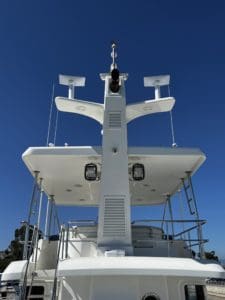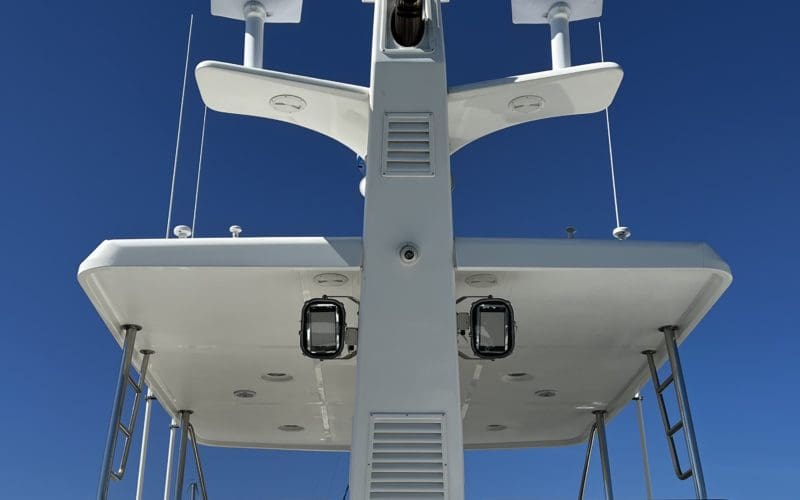
For years we’ve seen satellite domes multiply on boats like so many plastic mushrooms. Now, a new player in the satellite market, Starlink, is making its way into the marine world. Even though Starlink is not officially for marine use, some enterprising boat owners have installed the system on their boats, with some undertaking informal testing of its effectiveness while underway.
Among these is Alex Dickinson, the owner of the Nordhavn 60, Cherry, based in Dana Point, Calif. An electrical engineer by training, Dickinson has had two Starlink antennas installed on Cherry. They occupy mounts that once sported sat domes for systems from KVH and Dish TV.
Starlink, of course, is the satellite internet system from SpaceX. Starlink spacecraft circle the earth in low earth orbit (LEO), and SpaceX is launching them with abandon. The Starlink system currently has 2,300 spacecraft in orbit and has authorization from the FCC to orbit as many as 12,000.
Because these satellites are in LEO, with the highest orbit at 350 miles, signal latency and power requirements are lower than for geostationary (GEO) satellite systems, since the signals need only travel 350 miles, compared to the 23,000 miles to reach satellites in GEO orbit.
Dickinson, who works aboard his boat, uses Starlink for phone calls, Zoom video calls and general internet access. “I’m getting 200 megabytes per second download and 20 megabytes per second upload speed,” Dickinson said, although he stressed those were the best speeds he’s seen. More typical, he said, is 80 megabyte per second download and 10 megabyte per second upload.
According to the Starlink terms of service, the system is for home use, not for mobile applications. Thus, customers with Starlink systems on their boats are not breaching the terms if they use the system while tied to the dock. The significance of using Starlink while underway, however, is not quite clear. As Dickinson points out, Starlink is now selling its systems to the RV market and RV owners are placing the antennas on their vehicles. Are some of those customers using the system while moving? “Starlink knows where every antenna is located since the position is provided via GPS,” Dickinson said. “So if customers are using the system while on the move, Starlink is aware of that.”
For marine users, the general assumption has been that the system wouldn’t deal well with boat motion — unlike satellite systems with mechanically-stabilized dish antennas like KVH’s TracPhone, for example, Starlink’s antenna is fixed. Without that stabilization an antenna bouncing around in a seaway would seem likely to lose lock with the satellites.
Dickinson, with his electrical engineering training coming to the fore, has been conducting his own series of tests of the Starlink system during passages to San Clemente and Catalina Islands. His results are intriguing. “The Starlink antenna is a flat-panel phased array,” Dickinson said. “And it is able to track the satellites without any moving parts. Which means that as the boat moves it does fine. Pitch or yaw or roll is no problem [for maintaining a connection].”
Part of this ability to maintain lock is due to the fact that Starlink is connecting to a large constellation of LEO satellites, rather than working to maintain lock with a single GEO satellite 65 times farther away. The other part is presumably the ability of the phased array (which is an array of individual, small antenna elements spaced across the panel) to pick up “off-axis” satellite signals. And given that displacement vessels like Nordhavns probably don’t present the most dynamic motion challenge to the antenna.
Even though the FCC has yet to authorize Starlink for mobile use, in April Starlink signed an agreement with Hawaiian Airlines to provide in-flight service, while Royal Caribbean is working with Starlink and lobbying the FCC to allow the use of Starlink on its cruise ships. Given this activity, it seems a mobile designation is likely in the future.
Reflecting Dickinson’s interest, Starlink has become a popular topic among many Nordhavn owners. “Since I kicked off discussions on the Nordhavn owners group message board there have been over 200 posts on the subject,” Dickinson wrote in an email, “and folks experimenting with Starlink on their boats from Ketchikan to Cabo to Croatia.”
According to Dickinson, one physical upgrade for boating users would be improved weatherproofing for the flat panel antenna to ensure it stands up to the challenges of the salty marine environment.

